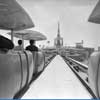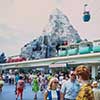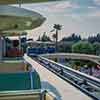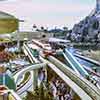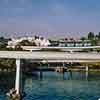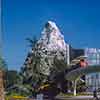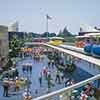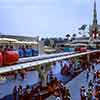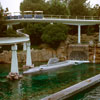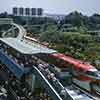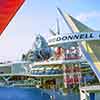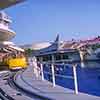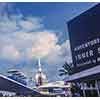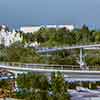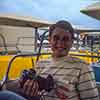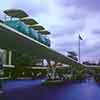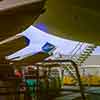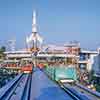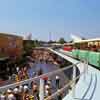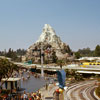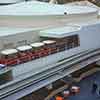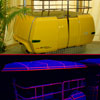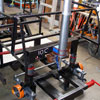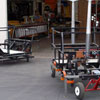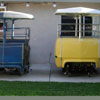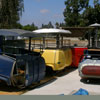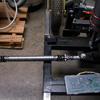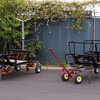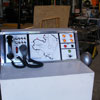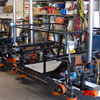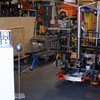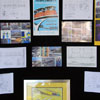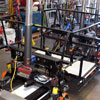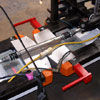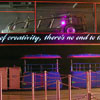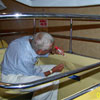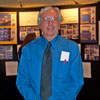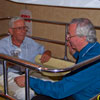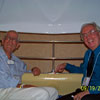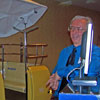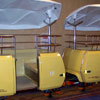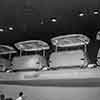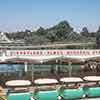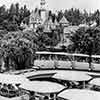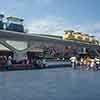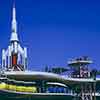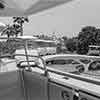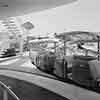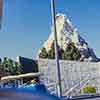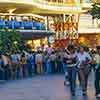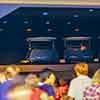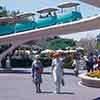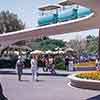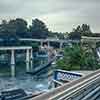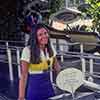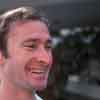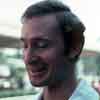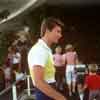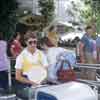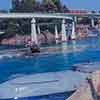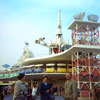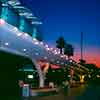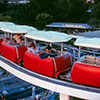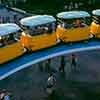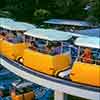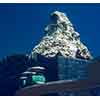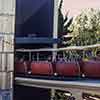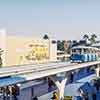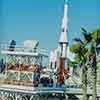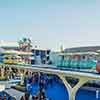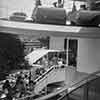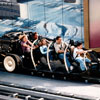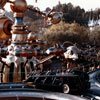KEVIN DOHERTY & THE CLASSIC PARK WHEELS ASSOCIATION
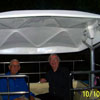 The name, Classic Park Wheels Association was suggested by none other than Bob Gurr (and who knows more about park wheels than he) during a gathering at my house in 2009. For as long as I can remember, I’ve had an interest in Walt’s concept for Disneyland (the original in Anaheim) as a location where Children and Adults can have fun, interact and LEARN together. A unique concept in entertainment…and in business. To be able to make it happen—in the 1950’s—and flourish all these years still amazes me.
The name, Classic Park Wheels Association was suggested by none other than Bob Gurr (and who knows more about park wheels than he) during a gathering at my house in 2009. For as long as I can remember, I’ve had an interest in Walt’s concept for Disneyland (the original in Anaheim) as a location where Children and Adults can have fun, interact and LEARN together. A unique concept in entertainment…and in business. To be able to make it happen—in the 1950’s—and flourish all these years still amazes me.
Yes, times have changed and there have been good years and bad, but the Park and the Company Walt Disney put together has somehow survived, and even flourished into an entirely new Theme Park Industry. We sometimes forget just how unique Walt’s dreams were for the time.
Still amazes me.
And “wheels”—especially Attraction wheels—have been a big part of that. And, Bob Gurr was the guy who made all those wheels a reality.
As “rides” come and go at Amusement parks (though they are so similar as not to notice)—“Attractions”—especially Disney Attractions—seem to live on even after a very successful life span. People—young and old—remember, fondly their first ride on Dumbo, Matterhorn, Big Thunder, Space and Splash Mountains; and “veterans” feel privileged to be able to reminisce about Flying Saucers, Sky Buckets, Viewliners, Astro Jets, and PeopleMovers. The Disney Company has allowed some of these “retired” ride vehicles to be placed in the hands of “regular” folks. By its nature, a very select and small group. Many feel it’s keeping a physical part of a fond memory.
I remember sitting in PeopleMovers in the 1970’s when I was a young adult (relocated from Boston) and being intrigued by the “Speedramps” and the automatically opening doors and tops. The relaxing excursion through Tomorrowland with the running commentary from Jack Wagner (what a voice). During the day, an escape from the crowds and heat on the asphalt; in the evening, the cool night air, usually music and sometimes, Fireworks!. Whether alone in a car (sometimes talking across to people you didn’t even know) or sharing it with a special “friend” (maybe that you just met, dancing at the Tomorrowland Terrace) always a very good attraction to go on—D-ticket or free.
It never came to mind back then that someday I’d actually be able to have a PeopleMover vehicle of “my own” but the day came! Since then, another came my way and even better…. after a “trade”, the 2 PeopleMovers I’ve got are sister cars… probably the only 2 surviving cars that are together now and were together at the start in 1967.
Still amazes me.
I’ve gotten a couple of other attraction vehicles, but these are my “Rolls Royces”. I’ve spent time, money and energy to restore and preserve them; not just for me, but for others who share and hopefully, understand their importance. I believe that these “Park Wheels” are not only a piece of our “childhoods”, but they are a piece of American History which should be cared for, displayed, and enjoyed.
People who own PeopleMovers, SkyBuckets, Mr. Toad and Space Mountain Cars….. should consider themselves privileged. Millions of people, around the world, have those same fond memories of these special vehicles. It’s fun and heartening to share.
A HISTORY OF TWO CARS
In 1966 a guy named Bob Gurr was asked by a guy named Walt to design a ride vehicle that could give an overview of a totally upgraded Tomorrowland section of The Disneyland Park. The locomotion of this attraction would be based on something designed for the 1965 Worlds Fair for the Ford Motor Company Pavilion. No separate vehicle motors, the cars would be carried along by motors and tires spaced in the roadway. Bob worked on this and came up with a design based on (believe it or not) a Cadillac and a soap dish.
248 separate cars in 4 car-trains would follow an elevated track through and around Tomorrowland in a relaxing overview of the Park.
One of these Trains was a bright yellow: train numbered #10. The two middle cars (#10B and #10C) moved excited visitors along the track, through “Monsanto”, “Carousel of Progress,” and “America the Beautiful” from 1967 to 1976. These 2 workhorses cycled their tops and doors every 18 minutes, carrying about a half million people around this track during that time.
In 1976 the attraction was closed because of the building of Space Mountain, and something happened to train #10—three of the Cars (10A, 10B, and 10D) ended up on display, at the entry of the turntable, high above the crowd for part of this year.
No one I can find knows why only 3 of the 4 car train ended on display or what was going on with 10C at that time, but we do know that 10B and 10C were reunited and placed back in service as they were part of the 1987 PeopleMover “re-paint” and got a new coat of silver/white with a bright Blue stripe.
In 1995 the PeopleMover was “retired”. Cars 10B and 10C had performed and shown about another half million guests Tomorrowland from above. That’s a total estimate of 1 Million guests between the 2 vehicles! The track fell silent and the constant feeling of motion and interest that the PeopleMovers brought to Tomorrowland was gone.
The PeopleMover vehicles were brought train by train into the now vacant Carousel of Progress/America Sings building to be “butchered”. A harsh word but it describes the process. The cutting off of the white fiberglass tops, tipping them over the side into waiting dumpsters. The cutting out of the aluminum towers and trim. The removal of the stainless guard rails and then the fiberglass skin to get to the steel frame. All thrown over the upper level track, sorted into waiting dumpsters below. It was necessary to make way for the new—but still very sad and depressing. Like losing a friend.
But—somehow, again- 10B and 10C were spared and set aside in a “bone yard” along with a few others and some Astro Jets. They sat there waiting their fate, which was to get a “fresh” coat of dark Blue paint and be striped with fluorescent orange tape!
In 1998, the old PeopleMover cars 10B and 10C found themselves “on stage” again as representatives of a now gone Tomorrowland Transit Authority mode of transport. A “preview” before you rode “Rocket-Rods”. A disappointing attraction. Good ideas, poor execution. Mostly due to “money control”.
Well, Rocket-Rods had issues and didn’t last very long. Cars 10B and 10C were “out of a job” again and sent to Burbank to sit in a back lot—in the weather….. forgotten perhaps?
No, someone at Disney got the bright idea (I’m not being sarcastic) that maybe there was a market for all this old stuff they had hanging around and maybe eBay could help. In 2002 Disney brought out their “stuff” and among the first on the “auction block” were PeopleMovers 10B and 10C.
Still dirty and scratched-up, on old pallets, PeopleMover 10C was sold first and a month later 10B.
I was lucky enough to get 10B and after a year of thought, I got into a “restoration” project. I was (am still) amazed at what Bob Gurr had created. Simple mechanism. All mechanical (no silly electric motors or fancy hydraulics. No computers!) and designed to do its thing for a long long time. The lack of wear on any moving part was amazing. Over their operating life, these doors and top had worked—every 18 minutes, for over 25 years, having about 500,000 people sit in this very vehicle.
Still amazes me.
Like a rare car restoration, we dismantled everything, cleaned, re-painted (returning it to the original yellow) and greased all. We even put in a small electric motor (sorry Bob) to duplicate the doors and top movement and a car stereo so we could even play Jack Wagner’s “PeopleMover” spiel. We placed it all on a pedestal and showed it off to fellow Disney enthusiasts. I still remember at one show allowing a dad and son—maybe 8 or 9 (too young to have ever ridden the attraction) - sit in it as the dad described the ride in detail, listening to the spiel, while the son listened to him reminisce. That made the project worth it.
All bright and shiny, Car 10B sat in our back yard. We’d have dinner in it. Overlooking the trees and grass, on cool nights, is always relaxing and brings back memories.
PeopleMover 10C had a tougher time of it, though. Something happened on the original eBay purchase and the sale wasn’t concluded. Someone at Disney decided it wasn’t worth much and so sold poor 10C as scrap! It was shipped to Florida, sitting on its original dirty old pallet. There a visitor from California saw it and negotiated a sale. It was shipped back to California and sat waiting its fate. After a few years, it was sold to another person and shipped to Hollywood, again to sit outside, waiting.
After the 50th Birthday of Disneyland, there was an auction. At this auction four of the few remaining PeopleMover cars owned by the Company were up for grabs. One of these was bought by a friend of mine. I called and congratulated him on his purchase, jokingly cursing him for now having two rare PeopleMovers. His response shocked me “I didn’t buy it for me, I bought it for you” he said! I was intrigued to say the least, as he already had a PeopleMover car and cared for Park ride vehicles as much as I did, he suggested that we might fix it up and make some money by finding a good home for this car if I didn’t really want it. I had a different idea and suggested I buy it from him so as to be able to trade with the owner of 10C. That would re-unite PeopleMovers # 10B and # 10C—the longest performing “on-stage” PeopleMovers—together, again! How cool would that be???!!!
He agreed and after almost a year of negotiations with the 10C owner (which included a car from Space Mountain) we did the trade and got 10B and 10C together again, in my back yard!
This was January 13th, 2008. Time went by—projects came and went—and, research on PeopleMovers and other attraction vehicles went on.
The “turning point” was October 10, 2009 when Bob Gurr accepted my invitation to visit my home. Wow! The information that guy remembers!
Still amazes me.
It was a small group of friends including Imagineers, prototypers and my fabricator. Bob answered questions, referencing my copy of the repair manual. His visit motivated me and right after Christmas, We started stripping, cleaning, cataloging, buying parts and steel, cutting, welding, sanding, priming, and painting.
THE “SERIOUS” BUILD
A friend had initially put the idea in my head that though all the original PeopleMover “lower chassis” (with the ride wheels and the Board that pushed them along) had been destroyed in the 90’s, it’d be fun to duplicate one and run it on a railed track. The concept was to do a “mock-up” by measuring the design from the maintenance manual and of course, Bob Gurr’s comments. We’d use structural steel and add plastic wheels and cheap threaded rod.
Well, after design, we were finding that the cost to get the stronger wheels or the better axels wasn’t that much. I remember standing looking at the first weld-up and wheel set with the fabricator and at the same time, we looked at each other and said “you know—I bet this thing will actually run on a track”.
Very cool.
500 man hours later, the 10C wheel chassis and car frame was complete and tested. It was June, 2010. The fiberglass body has gone out for repair—sand and paint.
Now it was car 10B’s turn for a new chassis and a “face-lift.” It took 4 hours to strip the 10B fiberglass, stainless and aluminum. Color coded (so the parts could go back on the same cars) the parts and frame traveled to the shop.
UPDATE 6/30/2010 Turned out that 10B “under the skin” was in pretty good shape, considering it had been 5 years since we did it… and, most of that time it was outdoors in all the weather. Rust had set in on the moving parts- not badly – but we decided to wire-brush everything and give it all a fresh coat of paint. We even color-coded the parts as we did on 10C.
I had 3 friends help that first day and BOY did they help. By the end of a long day, we had dismantled, cleaned and primer-coated all the parts. We cut the 2 pieces of inch and a half plywood, including the slight “curves on all ends. These “push-plates” were used to come in contact with the wheels in the roadway (Go-Go GoodYear!) and “push” the vehicles along. I was surprised when Bob Gurr had informed me these push-plates were just plywood. “Keep it simple – easily and cheaply replaced”. With some definite “pushing” from my friends to go on (boy was I tired after the first 10 hours)…. We even lined-up 10B with the cut steel and welded all the basic parts to the lower chassis…. Which I had planned to do a week later…
I was reviewing the PeopleMover “Maintenance and Repair” manual and looked at the pages about the control panels (there were 3). One console had a GREAT basic map with red lamps on it (for security) and another had a telephone and microphone (for the PA system). Son-of-a-gun—there’s a parts list with non-Disney part numbers. I wondered if these parts were still available? I googled the Electro-Voice Microphone part number and son-of-a-gun! I found an old stock microphone – in the box! And, then found lamps, switches and buttons all the exact parts used on these Consoles—thank goodness for the internet!
So, I think the next “project” will be duplicating a PeopleMover Console. I might even get it to actually open/close the doors and start the lights and sound on 10B and 10C —how cool would that be?
Moving on…. it’s not July as yet and we’re very close to wrapping up the mechanicals. found a couple of “oop’s” like welding the “feet and wheels on 10B backwards (had to cut and re-weld) and cut one plywood push-plate 1 inch too short (we’ll fix).
We did finish the Tow Bar that holds the 2 vehicles together. The original design was specially build and very hard (expensive) to duplicate exactly, but the simplicity of the original concept of 2 reciprocating springs (1966—no fancy hydraulics or electrics here) was easy to copy. Actually used 2 HD off road Bike springs. Now 10C will follow 10B, as it did in 1967. First weekend in July is going to be final frame / chassis painting and running the basic electrical wiring. Then on to Polishing all the wonderful stainless and aluminum.
UPDATE 8/2010: Because I’ve made a commitment to have these 2 PeopleMovers on display at a Disneyland Hotel event in mid September, working every weekend seems not to be enough. So, I’ve got a guy to polish all that aluminum and stainless… polish…polish…polish. Time consuming, back breaking, and messy…BUT once it shines, it’s GREAT. All the metal has been cut and base polished, now on to buffing and hand polish. The aluminum was in bad shape. Pitted from 40+ years out in the elements but, it looks great now.
Both 10B and 10C chassis and frames are assembled, even the wood “push plates” underneath are in (except for the curved ends; having trouble with them. They have rubber corners!).
When we placed them side by side to start the wiring, I almost made a big mistake. I placed 10B “in front” of 10C but forgot that the PeopleMovers ran clockwise, so I had to reverse them.
We “hooked up” the Tow Bar we had fabricated between the 2 cars and found we were less than ½ in from the original Blueprints! Cool…..
The wiring on 10B is mostly done and tested – lights, stereo, and door/top motor and timers. 10C is next. In as many places as possible, we used the original wire. Still got battery/ charger wiring to go.
The Painter has sanded and painted 10B exterior and fixed and reinforced all the exterior of 10C. 10C was in bad shape. Lots of cracks and brittle. Three coats of sanded primer. Of course, the fiberglass is over 40 years old. Glad it’s all there. Next is the interiors. Have to go from pictures to duplicate the original interior color (it was a tan color). After that will come the tops.
Even with all this, we’ve found time to play with the PeopleMover console. Basic “box” is done; might paint soon and then wire. Might be done in time for the display.
But PeopleMovers first—wish me luck.
I see “Light at the end of the (super speed) tunnel”
UPDATE 9/6/2010: 3 weekends have passed. The PeopleMovers are all wired, batteries in and lights, sound and door motors working. Even without the skins, they look great. The covered push-plate ends were quite a design issue but attached, with their metal covers and orange corner bumpers, they came out well and line up perfectly. We painted the outriggers red because they stick out from the frame. The outriggers are to hold on the white and chrome covers that were between and at the ends of the cars. Too bad I’ll not have these covers for a while as I need to fabricate them.
A fun distraction is that the PeopleMover control console came together faster than I expected. Not finished but, it looks very cool. The map warning lights actually “chase” and the big amber, red and green “warning lights” actually do operate the lights and doors on both PeopleMovers remotely. Very fun effect, can’t wait to show it off.
Painter has done all the outer skins (yellow) and says he’ll paint the interior parts (light tan) by the end of the week. Next, he’ll do the tops – when we sanded the top on 10B, we found a Bondo “patch” from here someone had tried to punch a hole in it. On 10C, the damage was even more severe as two of the aluminum post arms were cracked; one clean through. Just goes to show that Disneyland ride vehicles take a lot of abuse… but stand up to it quite well.
Once we get the skins and seats we can assemble. You know, assembling the fiberglass takes over 550 fasteners for each vehicle. We’ve over a thousand stainless steel screws, nuts, bolts and washers ready to go.
UPDATE 10/4/2010: “Disneyland (and, it seems the PeopleMover vehicles) will never be completed”
As I sit writing this installment (I thought it would be the last … maybe not) the event is done and the machines sit in the back yard, looking very cool. I’m told that they were the hit of the show. To get them there was…well, something else.
I was reminded by a friend that it’s like planning a wedding. You want everything to be perfect, but no matter how much time and planning you do, everything seems to fall apart and go wrong at the last minute. But—the big day comes, you see all the flaws…yet nobody else notices and everyone has a great time.
Same here. From running out of screws to the last batch of painted parts being done wrong to forever remaining “sticky” (seats no less) and worse, my wife went to emergency the afternoon before the event (she’s ok now)—everything went wrong. Did I mention that the weekend before, while screwing in a part, I pulled my elbow out? Hurt like heck and couldn’t use it for 2 weeks.
Despite the issues – I’m told by many that the units were a hit. My favorite moment was when Bob Gurr agreed to sign the inside “dash” of 10B. Very fun.
Many guests (there were about 500) took pictures and the most fun was seeing the smiles when they sat in them. I could tell they were remembering good times.
I was impressed not only with the guests’ interest and the usual questions (“Will they ever bring the PeopleMovers back?” being the most discussed) but with the interest and conversations in the technical aspects. People really care about Bob Gurr’s wonderful engineering.
The copy of the control box that had decided to give me fits during testing, worked perfectly all night and was the center of many discussions. Bob even explained the purpose of the 101 – 102 switch, which I had installed but had no idea of the function.
My one error of the night? The MC for the event was Neil Patrick Harris. I remember him coming over a couple of times during breaks and once he politely asked if he could take pictures. I was so pre-occupied, I didn’t ask if he had questions and didn’t get a photo with him. Hope he doesn’t think I was being rude. I know he was truly interested.
We dismantled the units and display the next morning and transported 10B and 10C to their new home in our back yard (they look and feel so much better in the open than in a building). Jan (my wife) and I will again be able to sit and enjoy some wine while listening to Jack Wagner’ s “Go-Go-Goodyear” spiel. Wonder which unit we’ll enjoy more: 10B or 10C?
We’ll still need to disassemble them once again to fix the painted panels that aren’t right but that’s for next year – just before we put down the track for them to run on…and start the next project, a working Autopia vehicle…or maybe the Space Mountain car? On a track? Did you know Bob calculated the frame for stresses on this car?
Boy, I love this stuff—hope you do too.
Many thanks to Kevin for sharing this fantastic story of his blood, sweat, and tears to preserve Vintage Disneyland!

